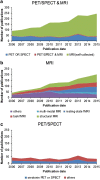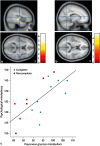Molecular, Functional, and Structural Imaging of Major Depressive Disorder
- PMID: 27142698
- PMCID: PMC5563774
- DOI: 10.1007/s12264-016-0030-0
Molecular, Functional, and Structural Imaging of Major Depressive Disorder
Abstract
Major depressive disorder (MDD) is a significant cause of morbidity and mortality worldwide, correlating with genetic susceptibility and environmental risk factors. Molecular, functional, and structural imaging approaches have been increasingly used to detect neurobiological changes, analyze neurochemical correlates, and parse pathophysiological mechanisms underlying MDD. We reviewed recent neuroimaging publications on MDD in terms of molecular, functional, and structural alterations as detected mainly by magnetic resonance imaging (MRI) and positron emission tomography. Altered structure and function of brain regions involved in the cognitive control of affective state have been demonstrated. An abnormal default mode network, as revealed by resting-state functional MRI, is likely associated with aberrant metabolic and serotonergic function revealed by radionuclide imaging. Further multi-modal investigations are essential to clarify the characteristics of the cortical network and serotonergic system associated with behavioral and genetic variations in MDD.
Keywords: Functional connectivity; Magnetic resonance imaging; Major depressive disorder; Molecular imaging; Positron emission tomography; Serotonin.
Figures






References
-
- Global Burden of Disease Study C. Global, regional, and national incidence, prevalence, and years lived with disability for 301 acute and chronic diseases and injuries in 188 countries, 1990-2013: a systematic analysis for the Global Burden of Disease Study 2013. Lancet. 2015;386:743–800. doi: 10.1016/S0140-6736(15)60692-4. - DOI - PMC - PubMed
-
- Gartlehner G, Hansen RA, Morgan LC, Thaler K, Lux L, Van Noord M, et al. Comparative benefits and harms of second-generation antidepressants for treating major depressive disorder: an updated meta-analysis. Ann Intern Med. 2011;155:772–785. doi: 10.7326/0003-4819-155-11-201112060-00009. - DOI - PubMed
Publication types
MeSH terms
LinkOut - more resources
Full Text Sources
Other Literature Sources

